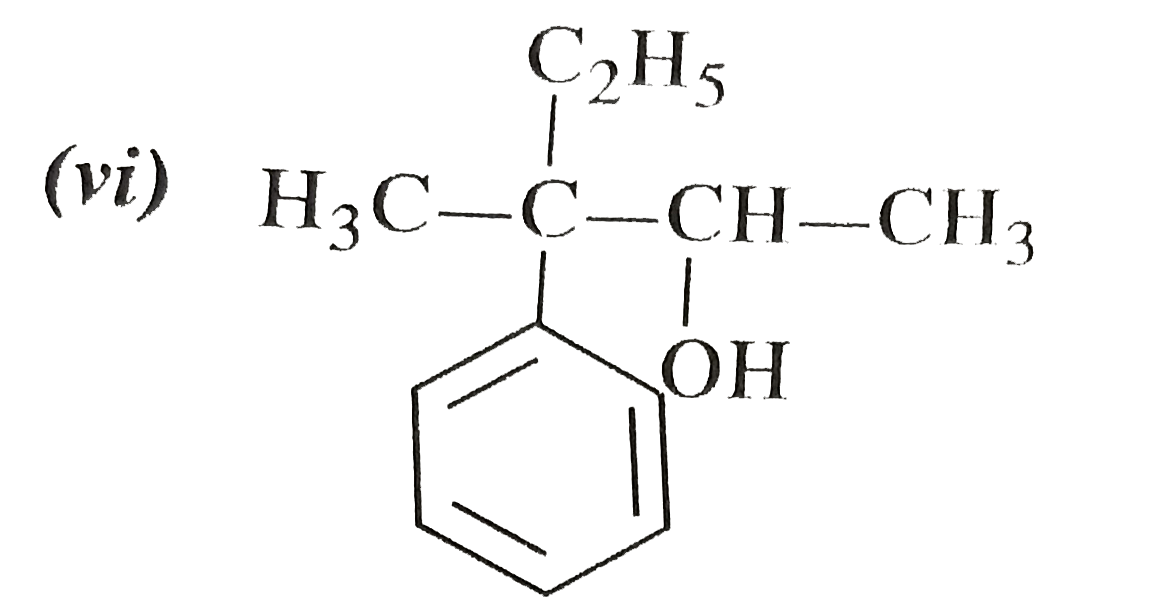निम्नलिखित यौगिक दिए गए है:
(a) CH3CH2OH (b) CH3COCH3 (c ) CH3−C∣CH3HOH (d) CH3OH
इनमे से कोन आयोडीन विलयन और NaOH के साथ गर्म करके पर आयोडोफॉर्म देगा?
केवल (b)
(a), (b) तथा (c )
(a) तथा (b)
(a), (c ) तथा (d)
The correct Answer is:B
Step by step video, text & image solution for निम्नलिखित यौगिक दिए गए है: (a) CH_(3)CH_(2)OH (b) CH_(3)COCH_(3) (c ) CH_(3)- underset(underset(CH_(3))(|))(C )HOH (d) CH_(3)OH इनमे से कोन आयोडीन विलयन और NaOH के साथ गर्म करके पर आयोडोफॉर्म देगा? by Chemistry experts to help you in doubts & scoring excellent marks in Class 12 exams.
Updated on:21/07/2023Topper's Solved these Questions
- HALOGEN DERIVATIVESBOOK - ALLEN HINDICHAPTER - HALOGEN DERIVATIVESEXERCISE - Exercise-III (Analytical Questions)
6 Videos
- HALOGEN DERIVATIVESBOOK - ALLEN HINDICHAPTER - HALOGEN DERIVATIVESEXERCISE - Exercise-IV (Assertion & Reason)
7 Videos
- HALOGEN DERIVATIVESBOOK - ALLEN HINDICHAPTER - HALOGEN DERIVATIVESEXERCISE - Exercise-I (Conceptual Questions)
22 Videos
- D और F ब्लॉक के तत्व BOOK - ALLEN HINDICHAPTER - D और F ब्लॉक के तत्व EXERCISE - EXERCISE - IV (Assertion & Reason)
22 Videos
- IONIC EQUILIBRIUMBOOK - ALLEN HINDICHAPTER - IONIC EQUILIBRIUMEXERCISE - Exercise -IV (ASSERTION & REASON)
28 Videos
Similar Questions
निम्न में से किसका द्विध्रुव आघूर्ण सर्वाधिक है
View Solutionकथन: एल्किल हैलाइड जल में विलेय नहीं है। कारण: हैलाइड ध्रुवीय होने के बावजूद यह जल के साथ हाइड्रोजन बंध नहीं बनाता है।
View Solutionएल्किल हैलाइड को निम्न के आलावा सभी से बनाया जा सकता है
View Solutionकथन : मर्करी का प्रथम IP केडमियम से अधिक है
कारण : Hg का स्थायी इलेक्ट्रॉनिक विन्यास है (5d106s2)
View Solutionकथन :- जब शुद्ध जल में कुछ मात्रा में अम्ल या क्षार मिलाते हैं तो इसका pH बदल जाता है।
कारण:-अम्ल या क्षार के मिलाने पर जल के आयनन की मात्रा बढ़ जाती है।
View SolutionFind out no of compounds that gives positive iodoform test (either in cold or hot condition)
(A) H3C−C∣∣O−CH2−CH3
(B) I3C−C∣∣O−CH2−CH3
(C) CH3−C∣OH−CH2CH3
(D) CH2l−CH∣OH−CH2CH3
(E) CH3CH2OH
View SolutionGive the IUPAC names of the following compounds:
(i)C6H5−CH2−CH2−OH (ii)CH3−CH3∣C∣CH3−CH2−CH2−OH
(iii)[(CH3)2CH]3COH. (iv)CH3−CH∣OH−CH2−CH2−O−CH2CH3
(v)CH3−CH2−CH∣Cl−CH∣CH3−CH3∣C∣OH−CH3 (vi)
(vii)(CH3)3COH (viii)CH3−CH∣CH3−CH∣OH−CH2−CH∣CH3−CH3
(ix) CH2OH |CH2−CH2−CH−CH−CH−CH3 | | CH2Cl CH3, (x) CH3−C=C−CH2OH | | CH3Br
(xi) CH2=CH−CH∣OH−CH2−CH3, (xii) CH2OH |CH3−CH−CH2−CH−CH−CH3 | | CH3 OH
View SolutionI. CH3−CH2−CH2−CH2−OH
II. CH3−CH2−CH∣OH−CH3
III. CH3−CH3∣C∣OH−CH3
IV. CH3−CH∣CH3−CH2−OH
V. CH3−CH2−O−CH2−CH3
VI. CH3−O−CH2−CH2−CH3
VII. CH3−O−CH∣CH3−CH3
Which of the above compounds form pairs of metamers ?
View SolutionI. CH_(3) - CH_(2) - CH_(2) - CH_(2) - OH II. CH_(3) - CH_(2) - underset(OH)underset(|)(CH) - CH_(3) III. CH_(3) - underset(OH) underset(|)overset(CH_(3))overset(|)(C) - CH_(3) IV. CH_(3) - underset(CH_(3))underset(|)(CH) - CH_(2) - OH V. CH_(3) - CH_(2) - O - CH_(2) - CH_(3) VI. CH_(3) - O - CH_(2) - CH_(2) - CH_(3) VII. CH_(3) - O - underset(CH_(3))underset(|)(CH) - CH_(3) Identify the pair of compounds that represents chain isomerism
View SolutionThe order of reactivity of following alcohols with halogen acids is……….
(A) CH3CH2−CH2−OH (B) CH3CH2−CH∣CH3−OH
(C)CH3CH2−CH3∣C∣CH3−OH
View SolutionThe order of reactivity of following alcohols with halogen acids is _____ (A). CH_(3)CH_(2)-CH_(2)-OH (B). CH_(3)CH_(2)-underset(CH_(3))underset(|)(C)H-OH (C). CH_(3)CH_(2)-underset(CH_(3))underset(|)overset(CH_(3))overset(|)(C)-OH
View SolutionFollowing compounds are given
(i) CH3CH2OH
(ii) CH3COCH3
(iii) CH3−C∣CH3HOH
(iv) CH3OH
View SolutionCH_(3)-CH_(2)-CH_(2)-underset(OH)underset(|)(C )H-CH_(3) and CH_(3)-CH_(2)-underset(OH)underset(|)(C )H-CH_(2)-CH_(2)-CH_(3) are
View SolutionGive IUPAC names of the following compounds:
(a) CH3−C∣OHH−CH2−C∣OHH−C∣C2H5H−CH2CH3 (b) CH3−C∣OHH−C∣OHH−CH3
(c)CH3C∣OHHCH2C∣CH3HCH2CH2CH2CH3 (d) CH3C∣CH3H−C∣OHH−CH3∣C∣CH3−CH3
(e) CH3C∣OHHC∣OHHCH2OH (f) C6H5CH2OH
(g) CH3CH2CHCH4OH (h) CH3CH2CH2OH∣C∣C6H5CH2CH3
(i) CH3OH∣CHCH2OH∣CHC∣CH3H−CH3 (j)
View SolutionThe order of reactivity of following alcohols with halogen acids is ………
(A) CH3CH2−CH2−OH
(B) CH3CH2−C | CH3H−OH
(C ) CH3CH2−CH3| C | CH3−OH
View Solution
